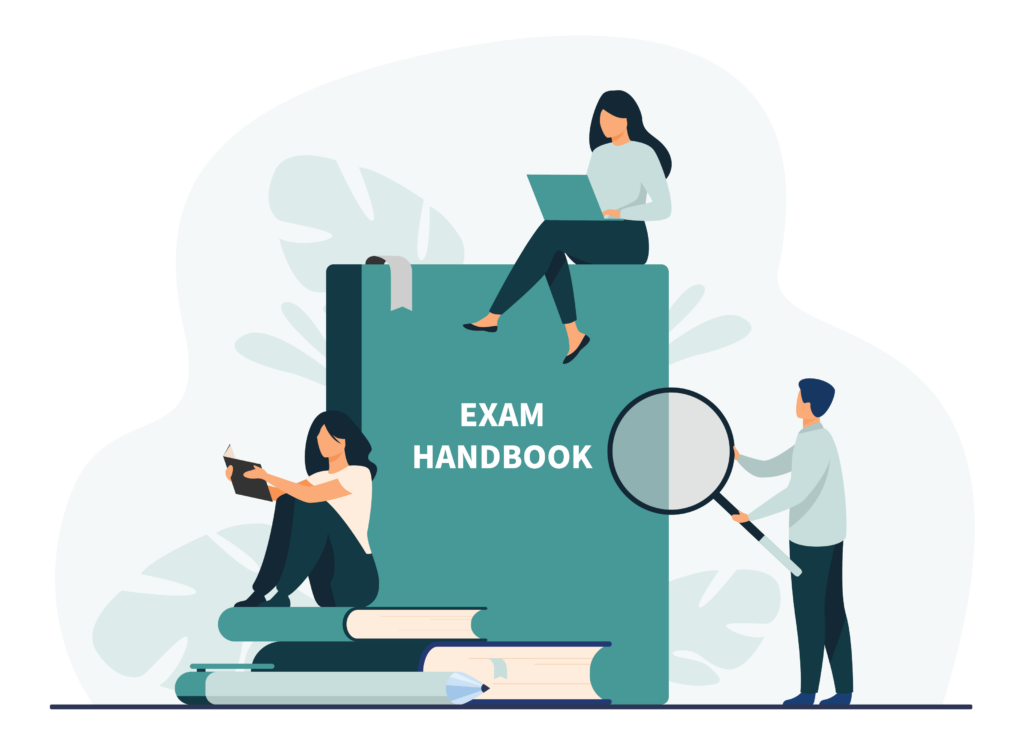It’s no secret that professional credentialing is becoming more competitive—driven by a growing demand for certification and expansion of credentialing programs. While the landscape is competitive, a top priority for many programs is ensuring a smooth testing journey that minimizes unsatisfactory experiences for candidates. Given the resource constraints faced by many programs, effectively managing the candidate experience is more important than ever.
How Can You Enhance the Overall Testing Journey for Your Candidates?
Every touchpoint in the professional credentialing journey provides an opportunity to shape a candidate’s perception and preparedness. And creating a positive experience involves more than just managing day-of logistics; it requires thoughtful attention from start to finish. Let’s explore some of the critical components that influence a candidate’s journey through the professional credentialing cycle.
Component #1: Candidate Handbooks

Many test sponsors question the necessity of candidate handbooks and wonder who—if anyone—actually takes the time to read them. Our emphatic stance: Handbooks help communicate essential information to candidates, including your program’s policies and procedures. Should the defensibility of an exam ever be questioned by a candidate who claims they didn’t know relevant information, the handbook can act as an undisputed reference point.
Despite their importance, handbooks are rarely read from front to back. Instead, candidates typically consult them only when they need clarity on a specific issue or seek more information about a certain topic. To increase the likelihood that your candidates will engage with it, consider simplifying the handbook’s information into digestible snippets; using bullet points, graphics, or FAQs; and ensuring it’s accessible in multiple formats.
Component #2: Registration and Payment
One of the first touchpoints that many candidates have with a credentialing body is during test registration and payment. When these processes are smooth and user-friendly, they build trust and confidence. This assures candidates that the organization values their time and is committed to providing high-quality service.
These interactions set the tone for the rest of the candidate journey, but credentialing bodies handle them in different ways. For some programs with strict approval criteria, outsourcing to a vendor can free up internal resources and save time by managing applications, approvals, and scheduling procedures. Other programs, however, prefer to handle these processes in-house so they can directly manage eligibility requirements and maintain closer oversight.
Business models and preferences often influence which approach a program takes. Regardless of whether your program handles these processes internally or externally, they should align with your unique requirements while prioritizing a seamless and secure candidate experience.
Component #3: Candidate Management Systems
Efficiently managing candidate data is critical for maintaining the integrity of the testing process and providing excellent service to your end users. But deciding whether to manage candidates internally or to seek vendor support is a question that many programs grapple with.
To determine the best approach for your program, start by assessing your internal capabilities to handle and manage data. If your organization lacks the necessary expertise or resources, consider outsourcing to a vendor that can provide a robust candidate management system. And keep in mind that it can be advantageous for the system you choose to seamlessly integrate with the rest of your tech stack. This integration will directly enhance the testing journey, simplifying interactions for candidates while reducing potential confusion and delays.
Component #4: Practice Tests and Other Preparation Materials
The degree of a candidate’s readiness directly impacts their test performance. There are many ways to help prepare candidates for both the assessment and the testing event. Your program’s circumstances will dictate whether you conduct these activities in-house or partner with a specialized vendor to lighten the load. Here are a few common considerations:
- Practice tests featuring retired exam content or content that’s been developed specifically for practice purposes
- Practice tests in the actual test environment or in one that closely mimics it
- Study guides or course materials covering all tested topics
- Flashcards and/or mobile apps to help candidates understand processes and reinforce knowledge
- Pre-test workshops or seminars that focus on testing techniques as well as stress and time management
While the benefits of providing these resources are innumerable, there’s a big caveat: Many accreditation bodies, like the National Commission for Certifying Agencies, require a clear separation between a program’s credentialing processes and its training resources. Some accredited programs find it challenging or unnecessary to provide these types of resources, whereas others find innovative ways to do so without compromising accreditation standards. Credentialing bodies often create separate entities for certification and training to ensure distinct financial, managerial, or strategic operations.
Component #5: Testing Modalities

In recent years, many credentialing bodies have expanded their testing options beyond traditional test center delivery to include live remote proctoring. This shift has prompted a reassessment of long-held assumptions about the superiority of specific delivery methods. And it’s led many test sponsors to acknowledge that the future of test delivery may be one where candidate choice reigns supreme.
Evaluating your program’s circumstances is key when deciding on the testing modalities that will work best for your program and candidates. Consider factors such as security, technological dependency, and candidate preference and accessibility. Understanding how these factors compare across testing modalities will help your program effectively serve your candidate population.
Ultimately, the goal is to create a seamless testing experience for your candidates regardless of whether you choose to conduct in-person, remote, or multimodal test delivery.
Component #6: Score Reporting
Score reporting can impact the candidate journey, especially for candidates who need to retest. Done well, score reports can empower candidates with valuable insights into their strengths and areas for improvement. Done poorly, they have the potential to sow confusion, erode trust, and diminish the perceived fairness and credibility of the entire credentialing process.
There are many ways to create valuable score reports, but here are a few:
- Design your reports so they’re easy to read and understand, using visual aids and avoiding jargon or complex statistical language.
- Prioritize the information that your candidates need most. Usually, that includes their performance breakdowns and any guidance for retaking the exam.
- Consider working with a dedicated psychometrics team to design reports that are both legally sound and understandable to a lay audience.
“A question that’s always worth asking is, ‘What information in your score reports truly matters to your candidates? Are Pass/Fail designations enough or does your candidate population require more detail to aid in interpretation? After you have an answer, you can consult your vendor on design so your candidates understand and find score reports useful.”
—Maria Incrocci, SVP of Assessment Development and Psychometric Services, Meazure Learning
Component #7: Feedback
We all know how important it is to gather candid and constructive feedback from candidates about the credentialing journey. The improvements made based on this feedback often make the journey smoother while building trust and engagement. This can lead to higher satisfaction rates and inspire candidates to become program advocates.
But identifying the most effective methods for collecting this feedback is a moving target. The right approach can vary based on the specific circumstances and goals of your program. Our suggestion is to implement various feedback mechanisms, such as post-exam surveys, focus groups, and feedback forms available at multiple touchpoints. Analyze this feedback systematically to identify trends and areas for improvement. Then, adjust your processes accordingly to better meet your candidates’ needs.
Conclusion
In a competitive credentialing landscape, test sponsors and solution vendors must ensure a smooth testing journey. Each touchpoint in this journey—from initial registration to the final score report—plays a crucial role in shaping candidates’ experience, perception, and overall satisfaction. Careful management of these touchpoints can help make the entire journey more meaningful and credible for everyone involved.
To learn more, check out our on-demand webinar “Mastering the Test-Taker Journey: A Panel Discussion on Strategies for Test Sponsors.”